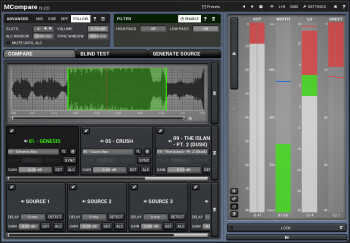This time we will look at a very specific way of listening to your mix: comparative A/B listening. I cannot recommend you enough this method – it's hands down the most important way to listen to your mixes in a home studio.
Everything is relative!
As its name implies, the basic principle behind comparative A/B listening is to compare the results of your mixing efforts with one or more professional mixes. This practice is pretty widespread among professionals, much more than you’d think actually, but it’s absolutely indispensable for home studio productions. Why, you ask? Well, because of the number one issue affecting almost every single home studio out there: far-from-ideal room acoustics. Your place most probably “swallows” some frequencies and boosts some others. It’s certainly hard to separate the wheat from the chaff when it comes to determining whether your mix will translate faithfully outside of your home studio. However, when you listen to a commercial song in your place you won’t be able to avoid the room’s shortcomings either. Hence, comparing your mix to a commercial one will allow you to asses your work relative to a track you know sounds good under any circumstance. This technique is a true Holy Grail for home studio owners because it allows you to work with absolute confidence. What else could you ask for?
Now you only need to learn to make the best out of this comparative session…
Choices
Before you start comparing anything you need to know what to compare. To choose the reference song or songs you need to consider two things, if you ask me.
First of all you need to consider the quality of the mix. That statement might seem obvious, but it’s indeed way more tricky than you think: we are not talking about the artistic quality of the composition, but rather the mastery of the mix. So put your musical tastes aside for a minute and concentrate on the technical achievements of the song you’ll use as a reference.
The other important point to consider is the relation between the song your are mixing and the famous reference song. Would it make sense to compare a classical music track with a Dub one? Or a track with a funky slap bass with one with a synthetic Moog-like bass line? Obviously not. So try to pick songs whose orchestration and genre are coherent with that of the song you are working on.
To finish, here you have three remarks which I believe are necessary.
First, use only quality sources as references: avoid any MP3 or similarly compressed files. You should use at least 16 bit/44.1 kHz WAV files.
Next, don’t forget that the reference track you choose has already been mastered. Pay special attention to the volume differences between the reference track and your mix, because it could bias your judgment. Try to level out the differences as much as possible when listening to both mixes.
Finally, I recommend you to compare parts that have a similar orchestral density when carrying out the comparative listening. In other words, it doesn’t make too much sense to compare an uber-busy chorus with a verse with almost no instrumentation. Once again, your choices ought to be coherent.
And that’s it for today. Next time I will show you some tools that can make your life easier when carrying out the critical listening of your mix.

